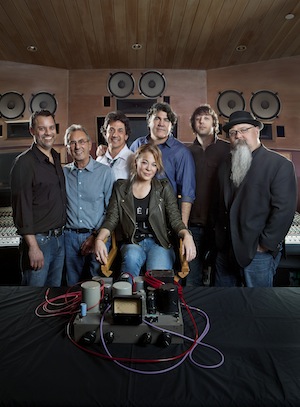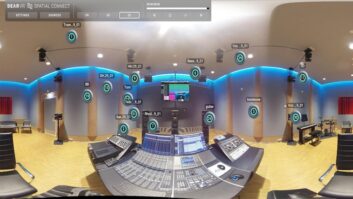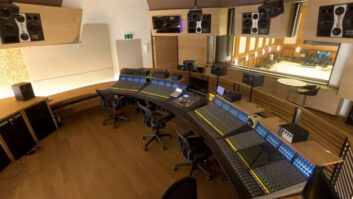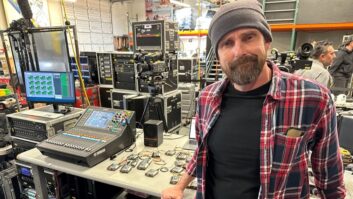
Left to right: Steve Genewick, Al Schmitt, Niko Bolas, LeAnn Rimes, Darrell Brown, Ian Sefchick, Vance Powell
Photo by Douglas Jessup
During the past few years, LeAnn Rimes’ private life has become tabloid fodder, the result of the public’s insatiable appetite for titillation. Being the constant subject of gossip, rumor and innuendo was understandably horrific for Rimes. So, in a sustained act of self-therapy, the 31-year-old artist, who’s been making records since the age of 13, set about working through the intense emotions she was feeling in the songs she was writing, while also seizing on a handful of outside songs—notably including Missy Higgins’ powerful “Where I Stood”—that perfectly expressed her tormented state of mind.
Songwriter/producer/arranger Darrell Brown, who has been Rimes’ writing partner and friend for more than a decade, was a willing facilitator in this outpouring, serving at once as co-writer, exorcist, cheerleader and shoulder to cry on. He was acutely aware of Rimes’ need to fearlessly let it all hang out. “‘Borrowed’ is about an affair, and how pathetic she felt finding herself in the middle of something,” Brown says of one of the album’s cornerstones. “She didn’t know she could be that honest.” Dan Wilson, who co-wrote “Borrowed” and “I Do Now” with them in a “fruitful” two-day session, describes the results of their collaboration as “very revealing, exposed and raw.”
“A lot of crappy things made for some great songs—thank God I have that outlet,” says Rimes. “But I hadn’t used it to its fullest before. Everything that was true was out there, and those things that weren’t true people believed anyway. So I felt like I had nothing to hide anymore. A humanity started coming out through the writing—a lot of tears were shed. And the songs I didn’t write I felt were incredible; I couldn’t write them any better.”
When the songs had all been written and selected, Rimes and Brown faced the challenge of how to bring this thematically taut material to life in the studio. The recording approach they chose hewed just as closely to “keeping it real” as did the songs they’d be cutting. “I wanted to be authentic and honest on this record,” says Rimes.
Says associate producer and engineer Niko Bolas, who’s been working with Brown for nearly 30 years: “Most of what I do is based on the way I was brought up, which was making Ronstadt and Henley records back in the day, when everybody went for performance around the vocal. LeAnn has been through a tumultuous couple of years, and she collected a group of songs that lyrically carries everyone who wants to know the truth from beginning to end, how it tore her up and how she found peace and resolve. So the idea was to deliver her believing the words. If you can get somebody who can sing like LeAnn can sing believing what she’s singing, then whatever emotion she’s feeling, you get it. And that’s what Darrell wanted to get.”

Niko Bolas
Photo by Sara Hertel
Brown puts their shared intent more succinctly: “It’s like the old days—let’s freaking capture it.
“Because I’m a songwriter first, I’m primarily song-driven as a producer,” Brown continues. “I want to know what the narrative is and what the singer’s singing, and then I start casting accordingly from that.” For this project, he says, “I thought about what characters would be interesting to put into the room to challenge her.” He also wanted the range of players to represent the various aspects of Rimes’ sensibility—“the Texas and Appalachian strains in her voice, the R&B/soul/blues thing she got from being born in Mississippi and raised in Texas. So we got Steve Jordan [drums] and Willie Weeks [bass] to play on the bottom end, and then Dan Tyminski [mandolin, acoustic guitar], Paul Franklin [pedal steel], Waddy Wachtel and Dean Parks [acoustic guitars] on top, with everybody playing off each other.”
The rest of Brown’s A-team consisted of engineers Bolas and Steve Genewick, who’d be on the other side of the glass while Brown conducted, danced and kept the players psyched up in the tracking room. Al Schmitt and Vance Powell would do the mixing.
They tracked the album in Capitol Studio A. “We set up the room so that people didn’t really have to wear headphones, especially LeAnn,” Bolas explains. “She stood in the middle of this bed of music and just held the microphone and sang. That was one of her dreams—she’s always wanted to make a record where she’s singing for people. Traditionally, recording a vocalist is a very isolated affair. They put on headphones, they go into this world of echo that no one ever hears, they’re in a small box that gets a little stuffy, they’ve got this big, expensive microphone hanging in front of them, nothing to do with their hands, glass and a wall between them and the musicians, and the intimacy is fabricated. Most great singers can do that. But if you’re standing in front of drums, you’re singing with different phrasing than if you’re listening to drums on headphones. There’s just no way around it.
“So, with LeAnn, we wanted her in front of people,” Bolas continues. “The genius of what Darrell was doing was to break down all the isolation so that she had to bring the lyric, just like these guys were bringing the musicianship. And he did it. There were vocals where she wound up in tears over the mic and we couldn’t do another take because she had to go fix her makeup.”
“I always wanted to hold the microphone in the studio, because I can’t stand being confined in an iso booth and singing with this piece of pantyhose material in my face—it drives me absolutely nuts,” Rimes laughs. “It feels so confining, because I can’t put my body into it. So that was the first thing I asked Darrell and Niko when I got in the studio, and Niko was like, ‘Yeah, sure, why not?’ What I love about Niko is, if he can make it happen, he’s going to. So I ended up holding the microphone the whole time; I was lying on the floor half the time, dancing around, wherever I felt comfortable, whatever I wanted to do. It was great to have that open space, to be able to see everyone’s faces and for them to read my body language, to see where I’m going.”
Rimes has a history of blowing out microphones, and these sessions were no different. “LeAnn moves so much air when she’s on the mic and she’s not wearing headphones,” Bolas marvels. “She’s not working the mic, she’s just singing her lungs out, and diaphragms start flapping.” The solution came from Schmitt, who suggested she go with a Neumann 104, the same mic Diana Krall uses in live performance. They tracked the album in six days, and on the seventh day they recut 10 of the tracks, Rimes and the studio band sharing the tracking room of Capitol A with about 50 invited guests who were asked to be completely silent, forming what Brown describes as “a human heartbeat orchestra.” Three or four of these takes made the album, including the no-brainer single candidate “Gasoline and Matches,” written by Buddy and Julie Miller, which Rimes heard as a surefire rocker that also furthered the album’s thematic thrust. Bolas and Brown then added a pair of crucial overdubs: a vocal by Matchbox Twenty’s Rob Thomas and a solo by Jeff Beck—one of just two electric guitar parts on the album, which Rimes calls “the best solo ever.” Transmitted via Skype, it was the first thing Beck recorded in his new London home studio.

LeAnn Rimes
Photo by Sara Hertel
“The way I interpret my job is you shouldn’t know I was there,” Bolas explains. “So in playback, you should be able to frame, out of the left and right, what happened on the important side of the glass. Data is cheap, so you record at the highest sample rate you can effectively afford—if you have a big rig and you can run 192, do it—get the mics set up, and get out of the way. Just always be in record, so that when everyone forgets they’re in a studio and follows LeAnn as she dumps her guts, you’ve got something that will always measure—always—because it’s real. And when it’s done, all the sounds that LeAnn, Darrell, Jordan, Waddy and all those guys were hearing out on the floor play back sounding like what they were hearing. In other words, if you’re standing in front of the guitar, that’s the sound you want coming out of the speaker. You don’t want some fabricated interpretation of that sound, you want that guitar with that touch, with that feel; all the accents and dynamics are in the hands of the musicians.”
When it came to the mix, Brown and Bolas turned to Schmitt and Powell, who split up the tracks, working separately. “Al and Vance immediately got what this record was supposed to be,” says Brown. “They were gonna keep it full-bodied and make it shine as organically as possible.”

Steve Jordan
Photo by Sara Hertel
“The recording was nice and clear, it had a lot of depth,” says Schmitt. “But that’s Niko. Let’s face it, people will buy this record because of the vocal performance and where it sits in the record, so you don’t want to bury it. If you listen to any of my records, the vocals are always right in your face. On this record, I was able to use the live chamber at Capitol, No. 4, which is my favorite of all the live chambers. I set that on her voice, and it lifted it right up. LeAnn blew me away; she really is an amazing singer. And most of the songs are great.”
Brown and Bolas’ integration of old-school values into this state-of-the-art modern recording project extended to the mastering. “I recorded everything at 192k and then I cut it to lacquer,” says Bolas. “Vinyl adds a tool—it’s both an equalizer and a compressor—in a way that has not been reproduced digitally yet. When it comes off the needle, it’s like an old friend that you’d forgotten about. It started as an experiment. We took a mix that Al had just finished and took it to Ron McMaster, who cut it to vinyl and sampled that to CD, so that you get all the mono compression that happens on the bottom and all of the smooth, warm analog texture that’s kinda like a baby’s cradle around the vocal. I played it for Schmitt and Darrell and they both went nuts. So that was it—we had to do it for the whole album. And that was the last step of congealing Al, Vance and myself, because it unified everybody’s interpretations on what’s really an album and not just 12 cuts. It’s a body of work that, if you listen to it from start to finish, it’s a range of emotions during a period of her life. When we got done and we played it, LeAnn was in tears and everybody went, ‘Wow—what did we just do?’”

“The songs stand on their own, but the album as a whole really does tell a story,” says Rimes with understandable pride. “The title track anchors the record and tells you exactly where it’s going. I do feel like I’m spitting fire on this record, because they’re things I’ve held in for a long time, and they’re coming out through my music, which is the best way they could. It truly was cathartic to make this record. I’m not holding anything back, and I feel like I’m more than just a voice now.
“Life happened, and I got to make an album of honest music,” she continues. “None of us wanted it to end, we had such a great time. I feel like we went back in time, almost, making this album, and I can’t make an album any other way from here on out.”







